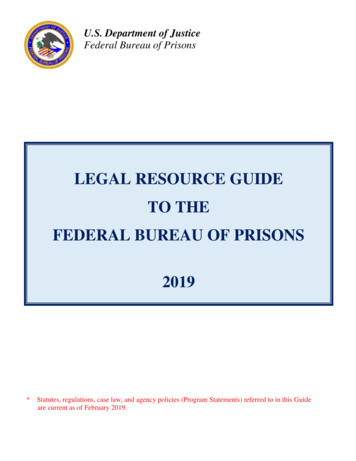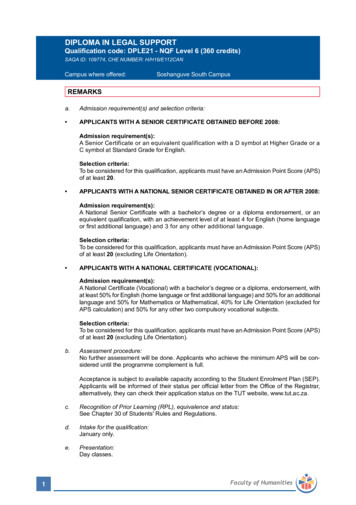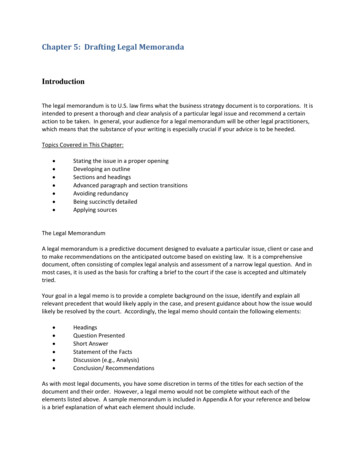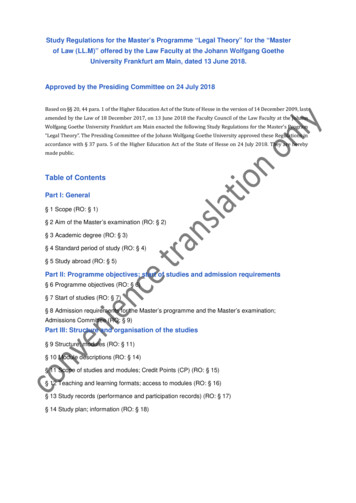
Transcription
U.S. Department of JusticeFederal Bureau of PrisonsLEGAL RESOURCE GUIDETO THEFEDERAL BUREAU OF PRISONS2019*Statutes, regulations, case law, and agency policies (Program Statements) referred to in this Guideare current as of February 2019.
Table of ContentsI.INTRODUCTIONA.The Bureau of Prisons MissionB.This PublicationC.WebsitesD.District of Columbia (D.C.) Code Felony Offenders12223II.PRETRIAL ISSUESA.Pretrial DetentionB.Pretrial Inmate Health Care333III.EVALUATION OF OFFENDER MENTAL CAPACITYA.Pretrial: Mental Evaluation and Commitment: 18 U.S.C. § 4241B.Pretrial: Determination of Insanity at Time of Offense and Commitment:18 U.S.C. §§ 4242, 4243C.Conviction and Pre-Sentencing Stage: Mental ConditionPrior to Time of Sentencing: 18 U.S.C. §4244D.Post-Sentencing Hospitalization: 18 U.S.C. § 4245E.Hospitalization of Mentally Incompetent Person Due for Release:18 U.S.C. § 4246F.Civil Commitment of a Sexually Dangerous Person: 18 U.S.C. § 4248G.Examination of an Inmate Eligible for Parole: 18 U.S.C. § 4205H.Presentence Study and Psychological or Psychiatric Examination:18 U.S.C. § 3552(b)-(c)I.State Custody, Remedies in Federal Courts: 28 U.S.C. § 2254;Prisoners in State Custody Subject to Capital Sentence,Appointment of Counsel, Requirement of Rule of Court or Statute,Procedures for Appointment: 28 U.S.C. § 226145SENTENCING ISSUESA.Probation and Conditions of Probation1.Community Confinement2.Intermittent Confinement3.Home Detention910101010IV.ii66778999
B.C.V.Imprisonment1.Institutional Confinement2.Service of Sentence in Non-Federal Facilities3.Juvenile OffendersJudgment in a Criminal Case1.Judicial Recommendations for a Specific Institution,Geographic Area, or Specialized Program2.Sentence Calculation3.Commencement of a Term of Imprisonment4.Credit for Prior Custody5.Credit for Satisfactory Behavior (“Good Conduct Time”)6.Fines and Costs of Confinement7.Inmate Financial Responsibility ProgramPOST-CONVICTION ISSUESA.Designation to a Facility for Service of a Term of Imprisonment1.Security Designation and Custody Classification2.DNA Collection3.Transportation to a Designated Institution4.Interstate Agreement on Detainers5.Central Inmate Monitoring System6.Communication Management Units7.Special Management UnitsB.Admission and Orientation Program for InmatesC.Programs and General Services1.Education and Recreation Programs2.Religious Programs3.Food Service4.Work Programs and UNICOR5.Inmate Accident Compensation(a)Lost-Time Wage Program(b)Compensation for Work-Related Physical Impairmentor Death6.Female Offenders(a)Birth Control and Pregnancy(b)Abortion7.Transgender Offenders(a)Designation and 16171718181819191920212121222223232324242425
D.E.F.G.H.I.J.K.(c)Searches of Transgender Inmates(d)Clothing and Commissary Items8.Substance Abuse Treatment9.Urine Surveillance Program10.Medical Services(a)Medical Services Available to Sentenced Offenders(b)Federal Medical Centers(c)Voluntary Mental Health and Medical Treatment(d)Managing Infectious Disease11.Mental Health Counseling and Treatment Services(a)Involuntary Mental Health Treatment(b)Mental Health Programs(c)Sex Offender Management and Treatment(d)Implementation of the Prison Rape Elimination Act of2003Visiting, Telephones, and Correspondence1.Visiting2.Telephones3.Written and Electronic CorrespondenceInmate Discipline ProcedureInmate Access to Court1.Law Libraries2.Preparation of Legal Documents3.Attorneys4.Legal Mail5.Unmonitored Legal Telephone Calls6.Inmate Involvement in Litigation While Incarcerated(a)Depositions(b)Subpoenas(c)Services of Process on Inmates(d)State Court Appearance of an Inmate(e)Inmate Access to Electronic Discovery MaterialsAdministrative Remedy ProgramInmate Personal PropertyInmate LiensSpecial Administrative Measures1.National Security Cases2.Prevention of Acts of Violence and TerrorismFamily Emergencies and Temporary 353636363737373838383939414142424242
L.M.VI.1.Furloughs2.Escorted TripsRelease1.Early Release from Prison(a)Executive Clemency(b)Reduction in Sentence2.Parole3.Pre-Release or Community Confinement4.Home ConfinementNotification to Community of the Release of an OffenderCONCLUSION4343434343444545464647VII. APPENDICESAppendix A – Summary Table: Application of Title 18 U.S.C. Ch. 313:Offenders with Mental Disease or Defect48Appendix B – Regional Counsel and Consolidated Legal Center Offices53Appendix C – Relevant Acronyms and Abbreviations55v
I.INTRODUCTIONThe Federal Bureau of Prisons (BOP), an agency of the United States Department of Justice(DOJ), was established in 1930 to provide more progressive and humane care for federal inmates,to professionalize the prison service, and to ensure consistent and centralized administration of the11 federal prisons in operation at that time. Today, the BOP consists of more than 122institutions, six Regional Offices, a Central Office (headquarters) located in Washington, D.C., aDesignation and Sentence Computation Center (DSCC) located in Grand Prairie, Texas, two stafftraining centers, and 24 Residential Reentry Management (RRM) Offices. Regional Offices andthe Central Office provide administrative oversight and support to the institutions and RRMs.The DSCC completes designations and sentence computations for the majority of inmates in BOPcustody; the Office of Medical Designations and Transportation (OMDT) will assign thoseinmates with specific medical needs. RRMs oversee Residential Reentry Centers (RRCs) andhome confinement programs. Inmates may be designated to any one of a number of BOPfacilities: a United States Penitentiary (USP); a Federal Correctional Institution (FCI); a FederalMedical Center (FMC); a Federal Prison Camp (FPC); a Federal Detention Center (FDC); anAdministrative Maximum Facility (ADX); or to a contract facility. Often, institutions with variedsecurity levels, are co-located, at a Federal Correctional Complex (FCC).The BOP is responsible for the custody and care of sentenced federal inmates as well as asignificant number of pretrial detainees and pre-sentenced offenders housed in our facilities onbehalf of the United States Marshals Service (USMS). The BOP also has custodial responsibilityfor District of Columbia felons sentenced to terms of imprisonment, and houses a number of stateand military offenders on a contractual basis. The current inmate population exceeds 180,000men and women, housed in both federal prisons and in private facilities under contract with theBOP. Approximately 18,000 inmates are housed in 11 contract facilities under the oversight ofthe BOP Privatization Management Branch.Federal Prison Industries (tradename “UNICOR”) and the National Institute of Corrections arecomponents of the BOP. UNICOR is managed by a Board of Directors, and the Director of theBOP serves as Chief Executive Officer. Created by Congress in 1934, this wholly-ownedgovernment corporation provides inmates with needed prison employment and the opportunity tolearn marketable skills. Items produced in UNICOR factories are sold to government agenciesnationwide. Many BOP institutions house a UNICOR factory or service.The National Institute of Corrections (NIC), established in 1974, provides training, technicalassistance, information services and cooperative agreement awards to service provider groups, andwill directly assist state and local corrections agencies. The NIC Director and 16-memberAdvisory Board, appointed by the Attorney General, advise assistance strategies and manage theInstitute’s funding priorities.BOP contracts with private firms with correctional expertise to operate prisons to house felonyoffenders, predominantly criminal aliens, who might otherwise be incarcerated in BOP facilities.The contractor is required to adhere to most BOP policies for offender management, and has1
day-to-day operations responsibility, with general oversight by the BOP PrivatizationManagement Branch.A.The Bureau of Prisons MissionThe mission of the BOP is to protect society by confining offenders in the controlled environmentof prisons and community-based facilities that are safe, humane, cost-efficient and appropriatelysecure, and to provide work and other self-improvement opportunities to assist offenders inbecoming law-abiding citizens.The federal prison system is the largest correctional system in the United States. Withapproximately 50,000 to 60,000 inmates released from federal prisons back to U.S. communitieseach year, reentry is a critical element of the mission of the BOP.The BOP's longstanding philosophy regarding reentry is that preparation for reentry begins on thefirst day of incarceration. To support reentry efforts, the BOP has changed its focus from anemphasis on clinical assessment and program participation to a competency-based model thatmeasures success by skill acquisition and ultimately successful community transition.B.This PublicationThis publication is intended to serve as a guide to relevant statutes, regulations, policy documents,and current case law concerning issues the BOP faces today. It provides a general overview of theBOP, its services, and its programs. Statutes, regulations, case law, and agency policies (ProgramStatements), referred to in this Guide may have been changed since publication. Thus, readers areadvised to review the website and confirm cited legal references when exploring BOP matters.BOP legal staff are located in the Office of General Counsel in Washington, D.C., RegionalCounsel’s offices, and in Consolidated Legal Centers (CLCs) servicing individual institutions (seeAppendix B). Further inquiries may be directed to the appropriate CLC.C.WebsitesThe BOP Internet home page is located at www.bop.gov. Consult the site for population data,policies/Program Statements, a directory of BOP facilities and offices, inmate locator information,employment opportunities, directions for inquiries under the Freedom of Information Act, andlinks to other relevant internet sites. The site for the National Institute of Corrections iswww.nicic.gov. UNICOR’s site is www.UNICOR.gov.2
D.District of Columbia (D.C.) Code Felony OffendersBy virtue of Section 11201 of Chapter 1 of Subtitle C of Title XI of the National CapitalRevitalization and Self-Government Improvement Act of 1997 (Revitalization Act), enactedAugust 5, 1997, Pub. L. No. 105-33, the BOP administers the imprisonment terms of felonyoffenders convicted under the D.C. criminal code. The BOP has broad authority to provide forthe “custody, care, subsistence, education, treatment and training” of D.C. Code felony offendersin its custody “consistent with the sentence[s] imposed.” D.C. Code § 24-101(a)-(b). With fewexceptions, BOP manages D.C. Code offenders no differently from U.S. Code offenders.II.PRETRIAL ISSUESA.Pretrial DetentionThe BOP and USMS cooperate to manage the allocation of federal detention bedspace. Pretrialinmates may be detained at BOP detention centers, and at other BOP facilities pending prosecutionand/or sentencing. The USMS acquires detention bedspace through agreements with state andlocal governments, and contracts with private vendors, in addition to the available BOP pretrialcells. The development of necessary detention resources in key districts, while emphasizingappropriately structured community supervision alternatives for non-violent offenders, is theprimary focus of this cooperative effort. To the extent practicable, pretrial inmates in BOPfacilities are separated from sentenced inmates, in accordance with 18 U.S.C. § 3142(i)(2).Should a court have concerns about conditions of confinement, access to medical care, or any otherissue relating to a defendant’s pretrial detention in a BOP facility, the BOP requests theopportunity to address such concerns prior to the issuance of a court order. See 28 C.F.R. pt. 551,subpt. J; Pretrial Inmates, Program Statement 7331.04. Parties raising such issues tend to seekinjunctive release in the form of an order compelling or directing the custodian of the detainee toaffirmatively act in some way or refrain from action. As the Warden or other custodian is not aparty to the criminal prosecution, the government attorney litigating the matter is urged to contactthe Warden or the BOP legal office at the affected institution for assistance in responding to theconcerns.B.Pretrial Inmate Health CarePretrial detainees held in BOP institutions are provided medical care on site by BOP staff andcontractors. The BOP is responsible for the costs associated with medical care provided inBOP-managed institutions and in the local community. The USMS is responsible for thetransportation of pretrial inmates in its custody to community-based medical services with theexception of USMS inmates housed at Consolidated Sites (i.e., MDC Brooklyn, FDC Miami,MCC New York, MDC Guaynabo, FMC Fort Worth and FCI Seagoville). The USMS willcontract for community medical providers as necessary to address the needs of inmates held innon-BOP facilities.3
There is virtually no health care issue that would preclude a defendant from commitment to afederal institution. Medical care is available in all BOP facilities. Male inmates whose healthcare needs exceed those services available in a typical institution may be transferred to a BOPFederal Medical Center in Springfield, Missouri; Rochester, Minnesota; Butner, North Carolina;Lexington, Kentucky; Fort Worth, Texas; or Devens, Massachusetts. Female inmates will betransferred to the Federal Medical Center Carswell in Fort Worth, Texas. Should an inmaterequire more specialized care, the inmate is sent to an appropriate community facility.Specialized health care for sentenced inmates is also available at a number of BOP institutions andall institutions are wheelchair accessible. See infra Section V.C.10, Medical Services.III.EVALUATION OF OFFENDER MENTAL CAPACITYIn 1984, as part of a major sentencing reform effort, Congress enacted comprehensive provisionsaddressing the evaluation and treatment of mentally ill offenders. Title 18 U.S.C. Chapter 313,§§ 4241-4247, describes necessary judicial procedures which must be followed when an offenderappears to be, or is, currently suffering from a mental disease or defect. See 28 C.F.Rpt. 549, subpt. C; Psychology Services Manual, Program Statement 5310.17; Forensic and OtherMental Health Evaluations, Program Statement 5070.12; Treatment and Care of Inmates withMental Illness, Program Statement 5310.16; Psychiatric Evaluation and Treatment, ProgramStatement 6010.03; Psychiatric Services, Program Statement 6340.04. The Adam Walsh ChildProtection and Safety Act of 2006 (Walsh Act), Pub. L. No. 109-248, provides for the civilcommitment of a sexually dangerous person subsequent to the completion of the term ofincarceration, as codified in § 4248. For more information on the Walsh Act, see infra SectionV.C.11(c), Sex Offender Management and Treatment. A Summary Table of the application ofthe following statutes, under Chapter 313, is attached as Appendix A.Evaluations may be performed by an outside (non-BOP) psychologist or psychiatrist byspecifically designating that condition in the study order. If the defendant is housed in a BOPfacility, a judge may designate in the order that an outside psychologist or psychiatrist be admittedinto the facility to conduct the examination. If the defendant is housed in a local non-BOPfacility, a judge may simply designate in the order that an outside psychologist or psychiatrist beadmitted into that local non-BOP facility to conduct the examination. The designated mentalhealth professional must contact the institution in advance to arrange admission into the facility toexamine the inmate and avoid unnecessary delays. A court-ordered study conducted by acommunity psychologist or psychiatrist is a far quicker and less costly process. If an FMCplacement is required, the statutory timeline does not begin until the inmate is received at thedesignated facility for evaluation.4
A.Pretrial: Mental Evaluation and Commitment: 18 U.S.C. § 4241Title 18 of the United States Code, § 4241, explains the procedures necessary to determine themental competency of a defendant at any time after the commencement of prosecution, and priorto sentencing. Should there be reasonable cause to question the defendant’s competency, thecourt will order a hearing upon the motion of one of the parties, or upon its own motion.See 18 U.S.C. § 4241(a). Prior to the hearing, the court may order the defendant to undergo apsychiatric or psychological examination. See 18 U.S.C. § 4241(b). BOP has specially trainedforensic psychologists and limited psychiatric resources, so such evaluation orders shouldreference a psychological evaluation, or a psychiatric evaluation but only when absolutelynecessary.The court may commit the defendant to the custody of the Attorney General for placement in asuitable facility1 to be examined for a reasonable period not to exceed 30 days, unless the directorof the examining facility requests a reasonable extension, not to exceed 15 days. See 18 U.S.C.§ 4247(b). After the examination period expires, a report is filed with the court by the facility’sstaff, and copies are provided to counsel. The BOP strongly encourages the court to have theinitial § 4241 evaluation conducted by outside non-BOP mental health professionals. This can beaccomplished by designating the outside specialist in the study order.Following the hearing, if the court finds by a preponderance of the evidence that the defendant ismentally incompetent, the court must commit the defendant to the custody of the Attorney Generalfor hospitalization and treatment in a suitable facility. This commitment period is for areasonable period of time, not to exceed four months, to evaluate whether there is a substantialprobability that, in the foreseeable future, restoration of competency will result. See 18 U.S.C.§ 4241(d)(1). 2An additional commitment period may be ordered if the charges have not been disposed of, and thecourt determines there is a substantial probability that the defendant will become competent tostand trial in the foreseeable future. See 18 U.S.C. § 4241(d)(2). The defendant cannot,however, be committed for a determination of his or her competency to stand trial for a periodlonger than the maximum possible sentence he or she faces. See United States v. DeBellis,649 F.2d 1 (1st Cir. 1981). If the defendant becomes competent to stand trial during theexamination period, the director of the examining facility files a certificate with the court statingsuch. A second competency hearing is held and, if the defendant is shown to be competent by apreponderance of the evidence, the prosecution resumes. See 18 U.S.C. § 4241(e).1In addition to BOP and USMS contract facilities, 18 U.S.C. § 4247(i)(A) authorizes the Attorney General tocontract with states, localities, political subdivisions, or private agencies for the confinement, hospitalization, ortreatment of a person committed pursuant to 18 U.S.C. Chapter 313.2The Supreme Court has held that the government may, in some circumstances, involuntarily administerantipsychotic drugs to a mentally ill defendant facing serious criminal charges in order to render the defendantcompetent to stand trial. See Sell v. United States, 539 U.S. 166 (2003).5
B.Pretrial: Determination of Insanity at Time of Offense andCommitment: 18 U.S.C. §§ 4242 and 4243Pursuant to 18 U.S.C. § 4242, the prosecuting attorney, after receiving notice that the defendantintends to rely upon the defense of insanity, may ask the court to order the defendant to undergo apsychological or psychiatric examination. Similar to a § 4241 study as described above, the§ 4242 study may be conducted locally or, where incarceration is deemed necessary, at a BOPfacility. After the issue of insanity has been raised, the fact finder is required to reach a specialverdict of guilty; not guilty; or not guilty only by reason of insanity.When an offender has been found not guilty only by reason of insanity, a hearing will be conductedno later than 40 days after the special verdict. See 18 U.S.C. § 4243(c). At the hearing, a personfound not guilty solely by reason of insanity has the burden of proving by clear and convincingevidence that his or her release would not create a substantial risk of bodily injury to anotherperson or serious damage to the property of another. See 18 U.S.C. § 4243(d). Note that whilethe hearing must take place within 40 days, § 4247(b) states that the examination under § 4243 maynot exceed 45 days. If the offender fails to meet the evidentiary standard, he or she will becommitted to the custody of the Attorney General.Once the offender has been committed, the Attorney General will make continuous reasonableefforts to release the offender to the state in which the offender was domiciled or tried, if the statewill assume responsibility for his or her custody, care, and treatment. The Attorney General hasauthority to stipulate the terms and conditions under which a federal insanity acquittee will beplaced in state custody for care and treatment. See 18 U.S.C. § 4243(e). There is a continuingfederal interest in the inmate’s state placement or conditional release, and any transferredindividual cannot be unconditionally released by the state facility without the concurrence of thecommitting court. Accordingly, prior to discharge, the director of the state facility must firstcomply with 18 U.S.C. § 4243(f), and notify the committing court of the potential release.The federal court, applying federal standards, decides whether the acquittee will, in fact, bedischarged.C.Conviction and Pre-Sentencing Stage: Mental Condition Prior toTime of Sentencing: 18 U.S.C. § 4244If a defendant is found guilty of an offense, but a question is raised as to his or her mental conditionprior to sentencing, the court may order a hearing and a mental examination to determine whetherthe defendant is presently suffering from a mental disease or defect such that commitment to asuitable facility for care or treatment, in lieu of imprisonment, is appropriate. See 18 U.S.C.§ 4244. If, after the hearing, the court finds by a preponderance of the evidence that suchplacement is appropriate, the defendant will be provisionally sentenced to the maximum termauthorized by law and committed to the custody of the Attorney General for hospitalization in asuitable facility. See 18 U.S.C. § 4244(d). If the defendant later recovers to the extent that he orshe is no longer in need of care and treatment, the defendant will proceed to final sentencing. The6
court then has the option of modifying the provisional sentence. While the statute envisions"commitment in lieu of imprisonment,” the § 4244 defendant actually faces an indeterminateperiod of commitment to a suitable facility for care or treatment; whereas, if he or she proceeds tofinal sentencing, there will be a definite term of imprisonment imposed, and the opportunity under§ 4245 to receive necessary treatment.D.Post-Sentencing Hospitalization: 18 U.S.C. § 4245Title 18 U.S.C. § 4245 provides for hospitalization and treatment of sentenced inmates found to besuffering from a mental disease or defect. If an inmate refuses to consent to hospitalization forcare and treatment, § 4245 describes the method for involuntary hospitalization if necessary.The court may order the hospitalization of an inmate for care or treatment if, after a hearing, thecourt finds by a preponderance of the evidence that the inmate is suffering from a mental disease ordefect for the treatment of which he or she is in need of hospitalization. See 18 U.S.C. § 4245(d).Section 4245(e) provides that the commitment may be discharged upon certification from theWarden that the inmate has recovered to an extent that he or she is no longer in need ofhospitalization, or upon the expiration of the sentence of imprisonment.E.Hospitalization of a Mentally Incompetent Person Due for Release:18 U.S.C. § 4246Title 18 of the United States Code, § 4246, provides for the commitment and hospitalization of aninmate who is scheduled for release but who is found to be suffering from a mental disease ordefect, and his or her release would create a substantial risk of bodily injury to another person, orserious damage to the property of another. If the director of a medical facility certifies that theinmate meets the standards set forth in § 4246(a), the director will file such certificate with theclerk of court. The certificate must also certify that suitable arrangements for state custody andcare are unavailable. A defendant found not competent and not restorable to stand trial under §4241(d), is also subject to the provisions of § 4246 if he or she meets the criteria for commitment.Once the certificate has been filed, the offender’s release is stayed. The clerk of the court willsend a copy of the certificate to the offender, to the attorney for the government, and if the personwas committed under § 4241(d), to the committing court. See 18 U.S.C. § 4246(a).The court will order a hearing to determine whether there is clear and convincing evidencethe person suffers from a mental disease or defect, such that his or her release would create asubstantial risk of bodily injury or serious damage to property. If sufficient evidence exists, thecourt will commit the person to the custody of the Attorney General. See 18 U.S.C. § 4246(d).The Attorney General will make continuous reasonable efforts to release the person to theappropriate official of the state in which the person is domiciled or was tried. If the state refusesto assume responsibility for the offender’s custody, care, and treatment, the Attorney General will7
hospitalize the individual for treatment in a suitable facility until the state assumes suchresponsibility or until the person’s mental condition is such that his or her full release, orconditional release, would not pose a substantial risk of injury to other persons or damage toproperty. The director of the medical facility may initiate discharge proceedings in accordancewith § 4246(e), or counsel for the inmate may seek discharge by filing a motion for a hearing.A motion by counsel for the inmate seeking discharge may be filed only after 180 days from thedate of a court determination that the person should continue to be committed. See 18 U.S.C.§ 4247(h).F.Civil Commitment of a Sexually Dangerous Person: 18 U.S.C. § 4248The Walsh Act, also known as the Sex Offender Registration and Notification Act (SORNA),enacted at 42 U.S.C. § 16911, provides for the civil commitment of sexually dangerous persons.Title 18 of the United States Code, § 4248, provides that the BOP may institute proceedings bycertifying that a person is sexually dangerous. A sexually dangerous person (SDP) is defined in§ 4247(a)(5) as one “who has engaged or attempted to engage in sexually violent conduct or childmolestation and who is sexually dangerous to others.” Pursuant to § 4247(a)(6), a person isconsidered sexually dangerous to others if he “suffers from a serious mental illness, abnormality,or disorder as a result of which he would have serious difficulty in refraining from sexually violentconduct or child molestation if released.” The Walsh Act requires the BOP to determine if aninmate being released is sexually dangerous, and to submit certification to the district court wherethe person is confined, to determine if civil commitment is necessary.The BOP Sex Offender Certification Review Branch (SOCRB) oversees the civil commitmentprocess. SOCRB reviews the assignments of all inmates prior to release, to ascertain whetherthere is any history of relevant conduct. For inmates with a record of attempted or actual sexualviolence or child molestation, an assessment is made of empirically-based static and dynamic riskfactors. Psychological and legal records are also examined. Consideration is given to a widerange of factors including criminal history, social and family support, mental and physical health,institution conduct, and other data. The Certification Review Panel (CRP) is tasked with makingthe final certification determination. Should the CRP find that an individual is an SDP,certification may delay the inmate’s release. A United States District Judge in the federaljurisdiction in which the offender is held will conduct a hearing and determine the merits of theCRP finding. If the court concurs with the CRP determination, the inmate is placed in the custodyof the Attorney General as a civil commitment. Efforts are then made to secure placement withthe individual’s state of residence. If those efforts are unsuccessful, the inmate will remain in theBOP as a resident in the Commitment and Treatment Program (CTP) until such time as the court ofcommitment determines the individual to no longer be sexually dangerous.8
G.Examination of an Inmate Eligible for Parole: 18 U.S.C. § 4205This statute was repealed (along with others pertaining to parole) in 1987. However, inmateswhose offenses were committed prior to November 1, 1987 (“old law”), D.C. offenders whocommitted their crimes before August 5, 2000, and military offenders transferred to BOP custodymay remain parole eligible. The statute requires the BOP to furnish to the United States ParoleCommission (USPC) an evaluation of an inmate’s suitability for parole, including his or hermental and physical health, past criminal history, and social background.H.Presentence Study and Psychological or Psychiatric Examination:18 U.S.C. § 3552(b)-(c)During the presentence investigative process, the court may order the defendant to undergo apsychological or psychiatric examination. The court will specify the additional information itrequires before determining an appropriate sentence.This evaluation may be completed by a community consultant “unless the sentencing judge
The Federal Bureau of Prisons (BOP), an agency of the United States Department of Justice (DOJ), was established in 1930 to provide more progressive and humane care for federal inmates,











